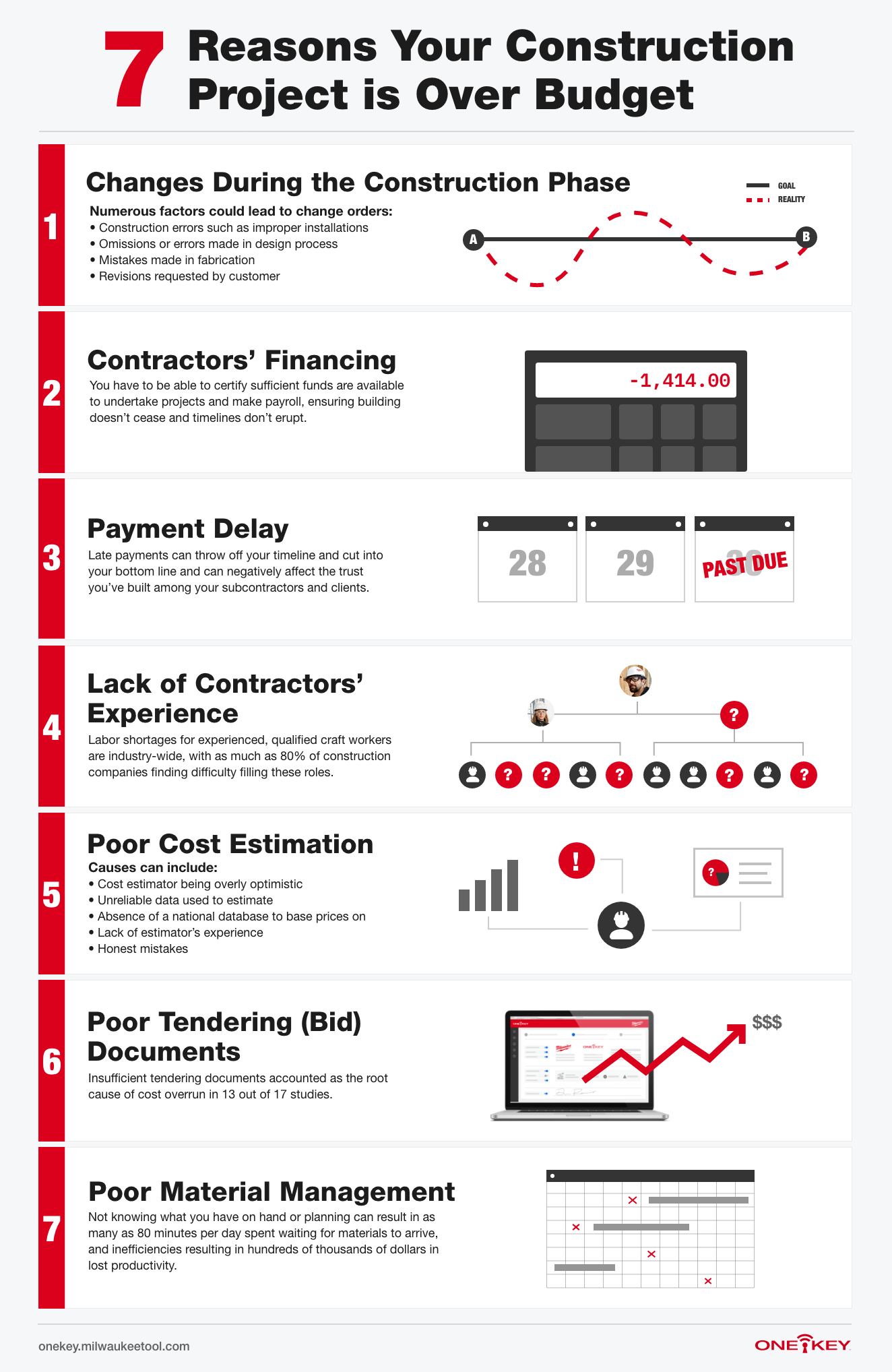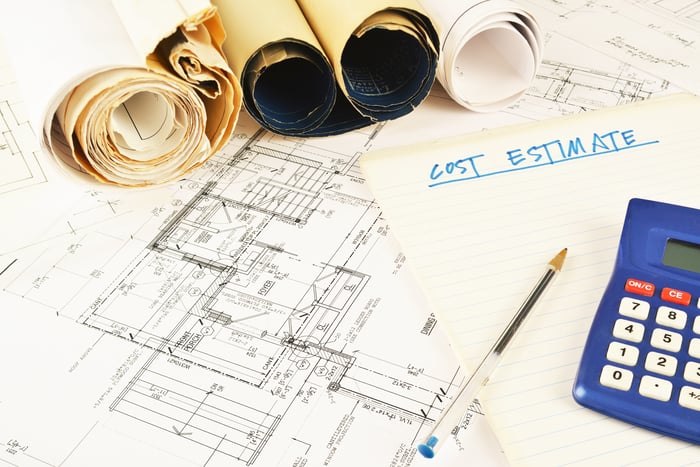It doesn’t help that construction material costs rose by 10% in 2019, either.
And while extenuating, unforeseen circumstances can occur that are worth quickly correcting to ensure your project timeline and budget don’t get thrown into a tailspin, most recurring cost overruns signal a deeper systemic issue that needs to be remedied to prevent further recurrence.
From adopting better planning methods, to creating a culture of transparency and collaboration among your workers clients and workers alike, to implementing technology to help digitize your efforts and keep everyone continuously connected, there are plenty of methods and tools that can help identify potential cost overruns and mediate them early in the process.
Thus, in this article, we’ll:
-
Unpack construction overruns,
-
Outlay the common causes and impacts often at play,
-
and offer some helpful tips and actionable strategies you can adopt to keep your project budget in line, with fewer surprises along the way.
What Is Cost Overrun in Construction?
Cost overrun, known also as a cost increase or budget overrun, is any unexpected incurred cost(s) that causes a project to exceed the overall budget (terms) you’ve agreed to with your client.
This can happen for a number of reasons (which we’ll discuss in the next section) and is usually tied to an underestimation of the actual cost of your project during the budgeting and project scoping phase.
Causes of Cost Overrun
What causes cost overrun? There are various factors—from material costs to labor shortages—that impact construction projects and could affect not only their progress and timeline but also could overrun the budget into the red.
The International Journal of Innovation, Management and Technology identifies 7 frequently identified causes of cost overrun in the construction industry, which we’ll discuss below in more detail:
-
Frequent design change during the construction phase
-
Contractors’ financing
-
Payment delay
-
Lack of contractors’ experience
-
Poor cost estimation
-
Poor tendering documents
-
Poor material management

1. Changes During the Construction Phase
Rework has become a surprisingly common trope of construction industry, with as high as 70% rework incidents due to design inconsistencies or errors.
Finding these design blunders in the field can lead to a contractor to making a change order—to add new specs or fixes needed to complete the job, all after initial models and budgets have already been completed.
Numerous factors could lead to change orders:
-
Construction errors such as improper installations
-
Omissions or errors made in design process
-
Mistakes made in fabrication
-
Revisions requested by customer
These additional requirements result in higher costs, bloating the original project budget, while additional time, manpower, and materials culminate in cost overrun.
2. Contractors’ Financing
Construction is unlike other businesses, like a retail store or repair shop, respectively curating a line of products or offering a service that is in turn exchanged for cash.
Contractors, who “receive payment after completing part of projects or the whole projects,” face a unique financing challenge—balancing multiple projects and budgets. They have to be able to certify sufficient funds are available to undertake projects and make payroll, ensuring building doesn’t cease and timelines don’t erupt. This delicate balancing act is continually weighted, with 25% of all projects growing past scope of work in the field by over 30%. What’s worse, this is now strained by the long-term effects of COVID-19 as important financing markets falter.
3. Payment Delay
In construction, your name is on the line. It’s important to be a high-trust construction company, able to stay true to designs and scope and deliver within timeline and on budget.
With small cash reserves on hand, it becomes challenging to pay subcontractors, creating a vicious cycle—failure to provide timely payments to trades for completed work makes it difficult for construction companies to meet project objectives, which in turn makes it difficult to maintain timelines.
As a consequence, late payments may accrue, which not only can throw off your timeline and cut into your bottom line, but also and more significantly, it can negatively affect the trust you’ve built among your subcontractors and clients.
4. Lack of Contractors’ Experience
Construction projects are becoming more complicated and requiring more time and expertise to complete.
Contrastingly, labor shortages for experienced, qualified craft workers are industry-wide, with as much as 80% of construction companies finding difficulty filling these roles, represented by 239,000 construction positions going unfilled in December 2019, according to the Bureau of Labor Statistics.
With a lack of contractor experience and associated expertise, expensive rework is always a risk. Aside from the associated cost, rework also can cause project delays and timeline deviation—nearly half of firms indicated labor shortages caused them to lengthen completion time for projects already underway. What’s more, as construction companies hire less experienced trades to fill these roles, more pressure is put on seasoned tradespeople to train new hires, which can complicate processes and require rethinking a traditional timeline until staff are fully onboarded.
5. Poor Cost Estimation
Estimators are hired to determine the expenditure of resources necessary to complete a construction project based on plans and specifications. This process is characteristically complex and involves collecting and manipulating large amounts of independent, but related, cost and non-cost data and information. It doesn’t help that construction projects carry a high degree of uncertainty, and much is unknown until projects break ground.
As a result, cost estimates might be inaccurate and lead to a cost overrun. Causes of inaccurate cost estimate are several:
-
Cost estimator being overly optimistic (known in psychology as optimism bias)
-
Unreliable data used to estimate
-
Absence of a national database to base prices on
-
Lack of estimator’s experience
-
Honest mistakes
6. Poor Tendering (Bid) Documents
Tendering, also known as bidding, is the process of inviting subcontractors to complete work on a construction project.
Insufficient tendering documents, according to the International Journal of Innovation, Management and Technology, accounted as the root cause of cost overrun in 13 out of 17 studies, and this could be a result of a number of factors:
-
Miscommunication between the contractor and designer
-
Insufficient details in the working drawings and a lack of coordination between necessary parties
-
Lack of human resources in the design firm
-
Designer’s lack of knowledge of available materials and equipment
-
The use of incomplete shop drawings and specifications
7. Poor Material Management
Not knowing what you have on hand or planning can result in as many as 80 minutes per day spent waiting for materials to arrive, and inefficiencies resulting in hundreds of thousands of dollars in lost productivity.
Impact of Project Cost Overrun
There are a number of direct impacts that cost overruns have:
-
Labor and manpower: Shortages in materials contribute to poor output and delays.
-
Admin and management: Those overseeing projects, particularly if they’re reporting to a board, face difficulties when having to prepare monthly profit and loss statements.
-
Reduced materials budget: Obviously, costs exceeding the original allotted project budget begin to eat into any contingency set aside, thus if any additional discrepancies or problems arise, profits can quickly disintegrate.
-
Lengthened timeline: Projects typically have multiple phases, relying on successful completion of each preceding phase. If budgetary constraints lead to phase delays, timelines evaporate.
-
Degraded reputation
cost of Construction Overruns
What is a typical construction cost overrun? McKinsey reported that large projects across asset classes typically overrun schedules by 20% and overrun budgets by 80%.
Cycle Construction had a similar figure, stating that nationwide construction cost overruns average 15% to 25% with "most lenders [recommending to include] a 20% contingency for project budgets."
What percentage of projects go over budget?
Drone mapping software company Propeller, meanwhile, figured that 9 out of 10 construction projects overrun, the overall percentage of projects going over budget being 28%.
How to Control Cost Overrun in Construction Projects
So, now that we’ve discussed the causes and impacts, how might you deal with a project cost overrun?
A very conservative approach to planning is key, and there are several factors that can help with this, which we’ll discuss below:
-
Construction Project Forecasting
-
Seeking Financial Support
-
Hiring the Right Team
-
Employing Productivity & Collaboration Tools
Construction Project Forecasting
Creating a construction project forecast based off of real-time data and getting the team involved early on, and communicating often, is a good way to set yourself up for success. This ensures project teams are aware of the parameters they’re working in, and they can communicate back potential issues before they get costly.
Financial Support
Getting the right financial backing from a company that understands construction can help ensure you stay in the green.
Construction loan management software programs exist to improve efficiency at the start of the loan through the servicing processes, also allowing both parties to reduce risk and consolidate construction loan activity in a single system. For example, Handle, a company recently featured in TechCrunch, “uses a mix of software and a financing line to help construction workers get paid on time.”
Hire the Right Team
Construction projects are getting increasingly more complex, so it’s in turn increasingly important that you hire the right kind of talent or reinvest in your current stable of talent. That way, you know your new hires will receive the right kind of training.
It’s important, for example, to have the right staff in place who will understand the new technologies necessary to undertake these complicated projects. After all, the construction industry is known as one of the least digitized industries with as much as 38.2% of construction firms citing a “lack of staff to support the technology” as a primary limiting factor to adopting new technology.
That means having the right team in to implement technologies like BIM that can improve the quality of the increasingly complex work you undertake. Considering that 30.9% of contractors won’t even bid on projects involving BIM, it’s never been more crucial to have a team of construction technologists and quality assurance experts at the helm of initiatives like this to prevent errors from making it back to the client and risk hurting your reputation.
At the same time, it’s equally important you have a detail-oriented construction project manager who can reliably set and measure objectives and KPIs for the team, a data specialist who can keep your teams in sync, and a construction cybersecurity expert who can keep your cloud-based construction enterprise fortified and protected from intruders (and you from liability).
Productivity and Collaboration Tools
There’s a lot of moving parts in the construction industry, and not surprisingly, 82% of owners admit they need more collaboration with their contractors.
That’s where implementing integrated construction software systems is key to make sure everyone is working off the same data. You might even consider streamlining your construction process in favor of a design-build method to limit the amount of third parties involved.
Additionally, cloud-based tools to digitally track and manage inventory, like tool tagging and kitting, can make sure materials and equipment are where they’re needed, when they’re needed, and prevent cost overrun-causing downtime.
Construction Job Costing (Updated for 2023)
Construction Job Costing (Updated for 2023)
Construction job costing is an important process employed by large construction companies, particularly as part of construction project management, to help managers stay on top of the budgets of multiple large-scale construction projects.
One such job costing example applied to inventory management practices can be seen in the recent feature we released to the ONE-KEY™ app:
- Users of the One-Key app can now assign daily and/or weekly rental rates to individual tools as well as tool kits they’re sending to a given job in bulk.
- When these tools are transferred to the jobsite, One-Key can calculate the cost accrued for each day those items are in the field.
Tying It All Together: Avoiding Cost Overruns in Construction
While materials costs are only bound to increase, preventing costly overruns starts with putting the right infrastructure in place:
-
Adopting better planning methods
-
Creating a culture of transparency and collaboration among your workers clients and workers
-
Implementing technology to help digitize your efforts and keep everyone continuously connected
With these important systemic changes implemented, the whole team will be empowered to identify potential cost overruns and mediate them early in the process.
TL;DR
There are 7 project cost overrun examples outlined by the International Journal of Innovation:
- Frequent design change during the construction phase
-
Contractors’ financing
-
Payment delay
-
Lack of contractors’ experience
-
Poor cost estimation
-
Poor tendering documents
-
Poor material management
Impact of project cost overrun can include:
-
Labor and manpower
-
Admin and management
-
Reduced materials budget
-
Lengthened timeline
-
Degraded reputation
How to Control Cost Overrun in Construction Projects:
Taking a conservative approach to planning and consider:
-
Using Construction Project Forecasting Methods
-
Seeking Financial Support
-
Hiring the Right Team
-
Employing Productivity and Collaboration Tools
- Construction Job Costing (Updated for 2023)







